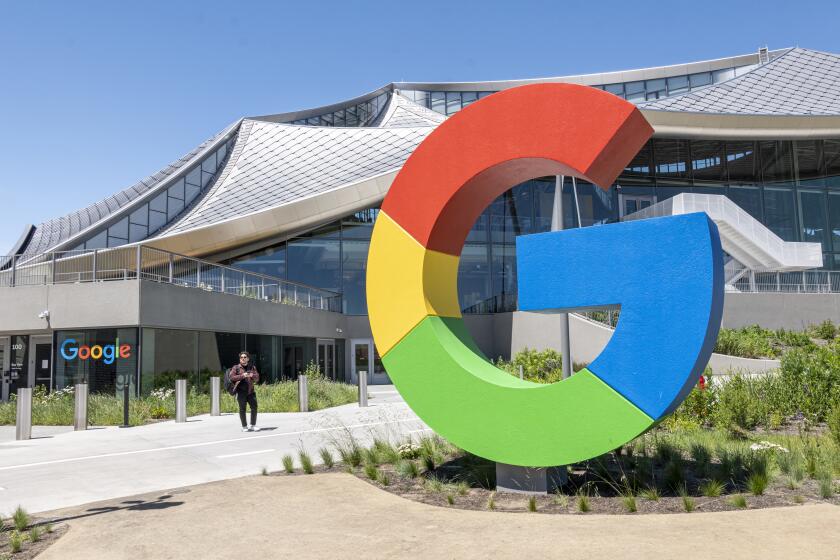Palm Pales Compared With New PDA Rivals
Palm Inc. essentially created the market for personal digital assistants with its Palm Pilot hand-held computer. Now the pioneering company risks falling behind its competitors because of its lackluster use of color.
It’s been nearly two years since Palm introduced its first model with a color screen, the Palm IIIc. But PDAs made by rivals have chipped away at Palm’s dominance by incorporating color in useful and innovative ways.
Color screens are increasingly common in PDAs. In 2000, the year color screens debuted, nearly 11% of the 2.8 million hand-helds sold in the U.S. had color screens. Among the 3 million PDAs sold last year through November, the proportion nearly doubled to 21%, according to market research service NPDTechworld. When December sales are factored in, the proportion of color PDAs probably will be even higher, said Stephen Baker, director of research for NPDTechworld.
In the meantime, Palm’s share of the market has slipped from 84% in January 2000 to 60% in November 2001, the most recent month for which statistics are available, NPDTechworld said.
All of the current devices running Microsoft’s PocketPC operating system--including Compaq Computer’s iPaq, Hewlett-Packard’s Jornada and Casio’s E-200--have color screens. Among Palm’s offerings, only the IIIc and the 10-month-old m505 sport color, and they don’t make the most of it.
“They’re using it effectively, but it’s not as effective as it could be,” said Aaron Marcus, an expert in designing graphical user interfaces for computerized products. “For the most part, the things that I see used are still just minimal.”
Upgrading from a monochromatic Palm Vx to a full-color m505 should be like throwing out a black-and-white television set and replacing it with a Sony Trinitron. Instead, it’s like watching an episode of “I Love Lucy” and seeing color only in the opening credits, said Roman Longoria, who runs the mobile applications group of Bay Chi, a Silicon Valley organization of usability engineers and human-computer interaction experts.
Palm representatives did not return calls to discuss the company’s use of color.
Desktop computers have made color an indispensable part of the user interface. On a PDA screen, with smaller icons and more potential for clutter, color could be even more useful.
“Color is a way to highlight things that are important and pull people’s eyes in certain directions,” said Elizabeth Rosenzweig, president of the Chicago-based Usability Professionals Assn.
But that doesn’t mean more color is necessarily better.
“If you don’t use color in a thoughtful way, it could be very misleading and very confusing,” she said.
Among usability experts, the mantra regarding color is “less is more.” Although new hand-held screens can display tens of thousands of colors, research shows that most people can keep track of just three to seven colors in their short-term memory. Besides, only three colors--red, yellow and green--have widely recognized meanings.
“The red-yellow-green of a stoplight is universal around the world,” Marcus said. “Red means there’s something that very much needs your attention. Yellow is a warning that something might need your attention. Green means everything is OK.”
When two events in a Palm Date Book overlap, the conflict is flagged with a red line. But it is so thin that it’s barely noticeable, which essentially defeats the purpose, Marcus said. A better use of color, he said, would be to tag work-related meetings with one hue and personal appointments with another.
Palm’s Address program uses color even more sparingly. The only substitute for black and white is the dark blue used to emphasize the title bar at the top of the screen and to highlight a selected entry.
Considering that Palm’s goal is to persuade consumers to spend $50 to $70 more for models with color screens, “the native Palm applications could be a little more effective in using color,” Longoria said.
But Palm isn’t solely to blame for the lack of colorful programs. The independent companies that create programs for PDAs also have been loath to invest in redesigns.
Vindigo Inc., the New York company that makes a popular program to help users find places to eat, shop and play, hasn’t done so because “only a minority of Palm devices in circulation support color,” Chief Executive Jason Devitt said. “If we’re not going to just colorize applications but are really going to rework them, there has to be a significant number of users to be worth it.”
The version of Vindigo made for PocketPCs sports full-color maps and other enhancements because “every single PocketPC is in color,” he said. As for the Palm hand-helds, “we were a little disappointed with the way color looks on those devices.”
*
Karen Kaplan covers the Internet. She can be reached at karen .kaplan@latimes.com.




